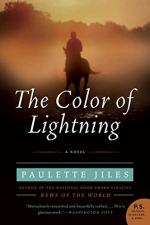|
This section contains 838 words (approx. 3 pages at 400 words per page) |

|
The Color of Lightning Summary & Study Guide Description
The Color of Lightning Summary & Study Guide includes comprehensive information and analysis to help you understand the book. This study guide contains the following sections:
This detailed literature summary also contains Quotes and a Free Quiz on The Color of Lightning by Paulette Jiles.
The following version of this book was used to create the guide: Jiles, Paulette. The Color of Lightning. HarperCollins e-books, 2009.
The Color of Lightning began at Britt Johnson's emancipation in 1863 on his family's way from Kentucky to Elm Creek on the Texas frontier. Britt, his wife, Mary, and his children Jim, Jube, and Cherry lived there peacefully until the morning of October 13, 1864, when hundreds of Comanche and Kiowa raiders attacked Elm Creek's unprotected women and children. Mary and the children were staying with Elizabeth Fitzgerald, her children Sarah Durgan and Joe Carter, and her granddaughters Lottie and Millie when the raiders descended upon them. They killed Sarah and Jim, taking the rest as their captors. The men repeatedly raped and beat Mary and Elizabeth, killing Joe. Mary sustained a brain injury from a blow to the head that affected her speech. She, her children, and Millie were taken by the Kiowa while Elizabeth and Lottie were taken by the Comanche when the bands split up to travel to their winter camps.
In Philadelphia in January 1865, Samuel Hammond, a Quaker and Civil War veteran, agreed to the Society of Friends Indian Committee's proposal for him to run the Indian Agency in Oklahoma. The Quakers intended to reinstate trust between the United States federal government and the Kiowa and Comanche through peaceful means and eventually assimilate them to American life on their reservations.
Back in 1864 with the Comanche, Elizabeth worked in a state of starvation, exhaustion, and rage for Eaten Alive's two wives. Lottie survived only because Pakumah, Eaten Alive's young wife, adopted her. Millie had been immediately adopted by Gonkon, the wife of Aperian Crow. Although Cherry was doted upon, she and Jube remained Mary's children. Jube began assimilating to Kiowa culture to improve their status within the tribe. At Elm Creek, Britt planned his rescue mission. He set out in April 1865 with his riding horse, Cajun, and a packhorse carrying supplies and goods to trade. Britt eventually came upon Tissoyo, a Comanche man, communicating with him in Spanish. Tissoyo promised to help Britt retrieve his family from the Kiowa.
Samuel began his journey to Oklahoma around the same time Britt's journey began. Along the way, he befriended a newspaper illustrator named James Deaver, whose experience lent more knowledge about the Plains tribes than the Society of Friends. Samuel had his first encounter with captives as he and his military escorts traveled by wagon. Upon arrival, he invited the Kiowa and Comanche to receive their first rations.
Meanwhile, Britt and Tissoyo continued traveling and building trust. When he saved Tissoyo from poisoning to death under a burning coal seam, the latter offered to give his prized horses in return. When they arrived at the Kiowa camp, Britt successfully traded for Mary and Cherry, but Jube stayed. A couple days later, he escaped on one of Aperian Crow's horses, reuniting with his family. At the agency, Samuel met with the Kiowa and Comanche headmen to ask them to stay on their reserved land and begin farming with little success.
Britt set out a second time to retrieve Elizabeth and Lottie from the Comanche, leaving Jube at the agency, where he translated for a Kiowa captive that had been returned in exchange for rations. At the Comanche camp, Tissoyo helped Britt by translating for him. Because the women feared Elizabeth, Britt easily bargained for her and Lottie. In 1867, Britt began his freighting business with his partners Paint Crawford, Dennis Cureton, and Vesey Smith. Britt was unafraid to traverse Comancheria during the raiding season, and he began freighting for the agency. Throughout this time, Mary struggled to overcome her trauma, and the children were uncomfortable returning to their American lives.
In late 1870, Samuel traveled to the Comanche and Kiowa winter camps to search for captives. When the headmen of both camps insisted that they did not have new captives, Samuel refused to give them their rations without captives to return, threatening imprisonment. The headmen stole their beef rations and demanded more, so Samuel issued their arrest on behalf of the state of Texas. Angered by Samuel's violence-prone decision, Deaver sent a letter to the Society of Friends, and Samuel resigned.
One day, when Britt was traveling alone, he heard singing in the fog and shot the man, whom he later discovered was Tissoyo. He continued freighting until one fateful day in early 1871 when a group of Kiowa attacked him, Paint, and Dennis with their wagons. The three men fought, but were killed.
History does not record the exact details of Britt Johnson's death, but an obscure marker exists at the site of the men's burial. Soon after Britt's death, the Warren Wagon Train Massacre motivated the United States federal government to end the Peace Policy and begin the Red River War, which decimated the buffalo population. Mary, Jube, and Cherry lived out their lives in Texas, and Millie Durgan lived with the Kiowa her entire life. The legend of Britt Johnson has been preserved through Texas oral history.
Read more from the Study Guide
|
This section contains 838 words (approx. 3 pages at 400 words per page) |

|



